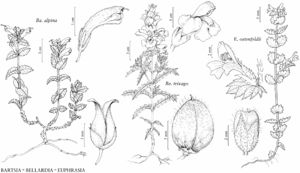Euphrasia ostenfeldii
Bot. J. Linn. Soc. 64: 359. 1971.
Stems simple or branched, to 12(–15) cm; branches 1–4(–6) pairs, from middle and distal cauline nodes; cauline internode lengths 0.5–3(–5) times subtending leaves. Leaves: blade suborbiculate, ovate, or oblong-ovate, 2–10(–14) mm, base round to cuneate, margins crenate to crenate-serrate, teeth 1–4(or 5) pairs, apices obtuse to subacute. Inflorescences sparsely spicate, not 4-angled, beginning at node 4–7(–9); proximal internode lengths 0.8–1.5(–2.5) times bracts; bracts +/- strongly flushed purple adaxially or on both surfaces, broader or as broad as leaves, suborbiculate, broadly ovate, or oblong-ovate, length not more than 2 times width, 4–8(–10) mm, base round, truncate, or broadly cuneate, surfaces +/- densely hirsute and hairs eglandular, teeth 3–5 pairs, as long as wide, apices subacute to acute. Flowers: corolla white, adaxial lip sometimes lilac, (3.5–)4.5–6 mm, lips +/- equal. Capsules elliptic-oblong to oblong, 4–5.5(–6) mm, apex retuse to emarginate. 2n = 44 (Europe).
Phenology: Flowering summer.
Habitat: Grasslands, dry or barren areas on limestone, stony and sandy places, rock ledges, near sea.
Elevation: 0–400 m.
Distribution
Nfld. and Labr., Ont., Que., Mich., Minn., n Europe.
Discussion
Selected References
None.
